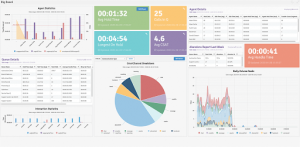There’s one common mistake I see businesses make when redesigning a website – they fail to plan effectively.
I get frustrated every time I see it happen. I know how much a website can make or break a business’s success because I’ve seen it first-hand. I’ve helped businesses take a poorly designed website and turn it into a conversion machine with some small, yet powerful, design switches.
Another reason I get frustrated? Redesigning a website is costly. It’s one of the biggest and most important investments your marketing budget will make.
Please hear me when I say this – Don’t skimp on the planning stage! It’s critical. Here’s why.
Plan For Conversion
The first step when you redesign your website is giving your users careful consideration. Where are they in the buying process? What answers do they need from you to make their decision about whether to buy or whether to bounce? How can you improve your customer’s experience to get better conversions?
The initial planning stage should examine what you and your users need to get out of the new website. Without this in mind, you won’t know where to start or what type of website you need to build. With it, you’ll have a beacon you can use at every step of the decision making process.
If you haven’t already, conduct some market research to identify your audience and their buyer personas. I recommend using emotional intelligence as a tool to think about your user’s journey through the buyer’s life cycle. This will help you to get to know them on a deeper level so you can plan the best way to convert your visitors once they hit your new site.
Clarify Your Website Objectives
Another step I always take with my clients before any redevelopment begins is to examine the key aims and objectives of the new site. What are you hoping to achieve by redesigning your website? What prompted you to want a new design, content or functionality?
Analyze Your Current Site
With your customers and objectives in mind, take a pulse on your website’s status today. Analyze your current site, thinking about questions such as:
- What has worked and what hasn’t?
- What is missing from the site?
- Where can you make improvements?
Conversion and automation are the two key factors you must consider during the analysis stage. They will help you to decide:
- Where you’ve lost opportunities and the best way to drive visitors to your new site
- How well you engaged with your audience in the past and what you can do better going forward.
- Where you missed conversion opportunities before and how you will change this on the new site.
Website Conversion Through Personalization
Your website is your primary tool for engaging and converting your target audience. It is your digital hub where your customers gather to learn more about your business. It’s critical it’s optimized to your visitor’s website experiences.
One of the best ways to do that is with personalized content.
This is where the market research I talked about earlier comes into play. By building a clear picture of who your target audience is you can then think about producing content for your website. This will engage your visitors and tailor the overall experience to their individual needs.
Through personalization, you offer a seamless process for your visitor to:
- Find out what he or she is looking for
- Stay on your site for longer
- Engage with your brand
- Become a buyer (the golden act you want her to take with your business)
When the content and sales copy on your website is personalized to your audience, studies show you increase the average time on your site by up to 193%. In turn, this extra time spent reading your writing could get you a 30% increase in conversion rates. That’s big time revenues!
Personalizing content isn’t easy. If it were, everyone would be doing it.
The hardest part is working out how you are going to show content that is relevant to your visitors. After all, they are all unique in their own way. This is where real-time personalization comes into play.
Using Real-Time Personalization for Website Conversion and Automation
Real-time personalization means being prepared to make a decision during a live interaction. This means, when someone lands on your website, you must be at the helm ready to give your website visitors a more customized experience.
This might sound daunting, but automation can help.
Too many of my clients think only about the message they want a customer to see at each stage of the buying cycle. Instead, think about each interaction.
- How can you send more relevant messages to customers depending on what they did on your website? Even though two customers might be in the same stage of the buying cycle, they still might want a different interaction from your company.
- Can you add any personal interaction on your website, such as a live chat feature with a customer service representative?
- Is your dialogue consistent across all your marketing channels? Or is the customer hearing from a different person each time she logs on?
- Are you using landing pages to cater your message to each niche customer who arrives on your pages?
When executed correctly you can increase sales and revenue, enhance your online conversion rates and strengthen customer loyalty.
Don’t Forget A Call-to-Action
Although calls-to-action are a basic element of any high converting page, many businesses fail to add them.
A call-to-action isn’t always “buy now.” Although that’s your ultimate goal, your website visitor might not be ready to make that kind of commitment yet.
Use your buyer personas and personalized content to understand what will realistically happen next. Maybe you’re trying to grow your email list so you offer an ebook to get your visitor’s contact information. Perhaps then, in one of the first emails you send, you offer a mini course for a fraction of the price of your full product. The goal is to progressively collect information from your visitors with each subsequent site visit.
A strong call-to-action provides:
- Focus to your site, with the key purpose of conversion
- A way to measure your sites success
- Direction to your users
If you struggle to identify the best way to offer a solid call-to-action I find it helpful to think about all the times I have signed up for things in my life. What did the seller do to encourage me to convert? How did they guide me through the sign-up process?
If you need some help with this I recommend reading 11 Kick-Ass Call to Action Examples, and Why They Work. There are some great examples in this article of call-to-actions done well by some of the leading online businesses around today including Crazy Egg, Square, Basecamp and Kissmetrics.
Takeaways
Yes, the website redesign process can feel quite daunting. I appreciate the amount of work that goes into creating a strong website because I do it on a regular basis. There are many factors to consider that will affect how your site will ultimately perform.
The planning process is vital in this process. If you fail to plan for your 2016 website redesign, you’ll fail to get the results your business is capable of achieving. The key is to think about how you will take your visitors on a journey through the site with conversion in mind. If you have this at the forefront of your mind you will be sure to make your new website a success.
Digital & Social Articles on Business 2 Community(8)






